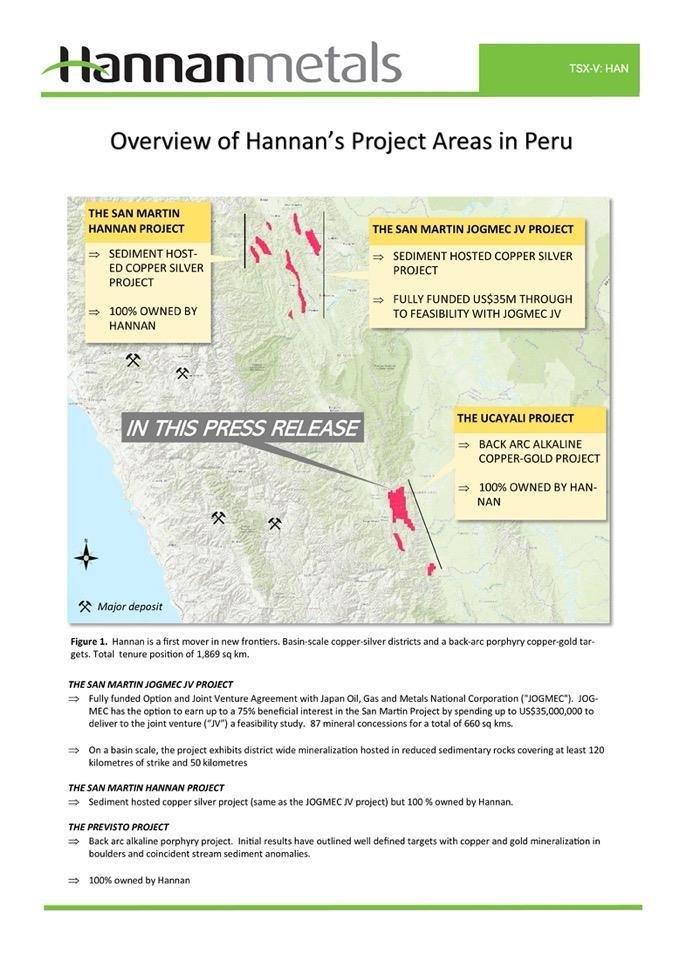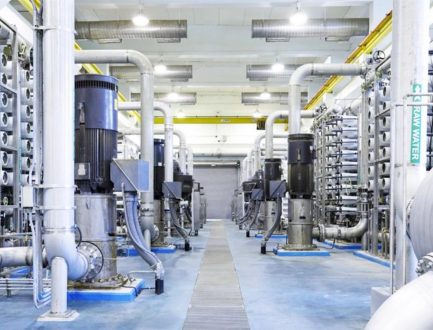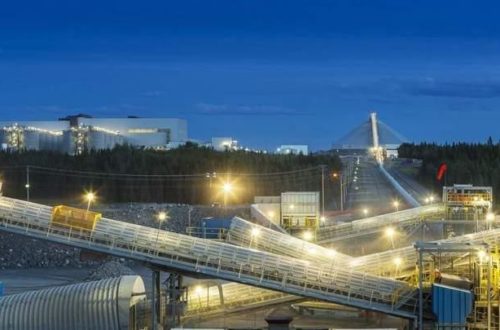
Hannan announces copper-gold porphry discovery at Ucayali in Peru samples up to 25.6% copper
Key points:
• At Previsto, initial reconnaissance field work has identified a large-scale hydrothermal system within a 6 kilometre x 3 kilometre area, that has the potential to host a porphyry copper-gold mineral system with an associated skarn (Figure 1).
o Multiple copper and gold mineralized float samples were identified within a 6 kilometre x 3 kilometre area defined by copper and gold anomalous stream sediment sampling. The best float sample assayed 25.6% copper and 28 g/t silver, sample 3703 (Figure 2-5) from an interpreted supergene enrichment zone;
o Exploration focused on a range that extends 10 kilometres in a north-south direction. The trend remains open to the north, west and south.
o Copper and gold mineralized porphyritic intrusive rocks were identified within float samples in creeks with propylitic, phyllic, intermediate argillic and potassium alteration, together with iron oxides, copper oxides, pyrite, chalcopyrite, chalcocite and neotocite;
• At Belen, a second copper and gold anomalous target was identified 20 kilometres south of Previsto. (Figures 2, 6 and 7). The zone is defined by altered outcrops and copper and gold anomalous stream sediment samples.
Michael Hudson, CEO states, “The back-arc basins of Peru have been sporadically explored over the last 30 years. The area represents a true last frontier within the metal-rich Andes mountain chain. In a similar way to our vast sediment-hosted copper-silver project in San Martin, we have once again opened a new search space in Ucayali, this time for copper-gold porphyry systems. Big systems have big footprints, and in a rare event, field teams were able to sample up to 25.6% copper in creeks within the first day or so of visiting the Ucayali project. Hannan is extremely well poised for a strong 2021 with a top 10 ground position in Peru, two extremely prospective and large copper projects, and a great joint venture partner JOGMEC earning up to 75% of the at San Martin project by spending US$35,000,000 to deliver a feasibility study.”
Technical background
Within the Ucayali project, initial work has identified two target areas (Previsto and Belen) prospective for copper-gold mineralization.
At the Previsto Cu-Au target (Figure 2-5) field observations suggests that the samples represent different parts of a mineralized copper-gold porphyry intrusion with an exposed zone of supergene enrichment, leach cap and phyllic, intermediate argillic and potassium alteration. To date, the source area of boulders and stream sediments anomalies is approximately 6 kilometres by 3 kilometres.
Eleven float (grab samples from river drainages) samples from Previsto ranged from 2.7 ppm copper to 25.6% copper, with an average grade of 23.7% copper and a median of 166.5 ppm copper, 1 ppb gold to 114 ppb gold, with an average grade of 20.1 ppb gold and 0.005 ppm silver to 28 ppm silver, with an average grade of 3.1 ppm silver. Float samples are selective by nature and are unlikely to represent average grades on the property.
Within the grab samples, the best copper results assayed 25.6% copper and 28 g/t silver (sample 3703) from semi-massive chalcocite float which is interpreted to be sourced from a zone of supergene enrichment. Minerals identified within grab samples by TerraSpec® spectral analysis clearly demonstrate hydrothermal alteration typical of a porphyry copper system, including: phyllic alteration with muscovite-paragonite-quartz, relict argillic alteration with a chlorite-muscovite assemblage. Macroscopically, relicts of secondary biotite were also observed. At this early stage, the paragenetic sequence of alteration appears to be potassic alteration (secondary biotite> potassium feldspar-magnetite), destroyed by the intermediate argillic alteration and later by phyllic alteration.
Mineralization consists of iron oxides, copper oxides, pyrite, chalcopyrite, chalcocite and neotocite. Gold and copper rich samples are associated with samples rich in potassium, interpreted to be related to white potassic feldspar and biotite. Potassium varies between 3-10% in copper-gold mineralized samples. Sodium varies between 0.2-4.2% and calcium between 0.06-5.2%.
Fourteen stream sediment samples from Previsto ranged from 9.0 ppm copper to 136 ppm copper, with an average grade of 29.1 ppm copper and 0 ppb gold to 404 ppb gold, with an average grade of 38.2 ppb gold. Stream sediment sampling is an early-stage exploration tool to cover large areas relatively quickly to identify smaller areas of interest to be followed up. The technique relies on sampling fine material in stream and creek beds that has been eroded from rocks in surrounding catchments, which represents a mixture of all the weathered material occurring upstream from the stream sediment sampling point. Copper and gold anomalism within stream sediment samples observed at Previsto is considered high.
At the Belen Cu-Au target, very early-stage field work has identified a second target 20 kilometres south of Previsto (Figures 2, 6 and 7). Reconnaissance field work by Hannan at Belen has identified an outcrop of dioritic intrusive, with argillic alteration overprinting an earlier propylitic alteration (chlorite>epidote), with 10 centimetre wide hydrothermal magnetite veins. Two grab samples from the outcrop were taken and anomalous copper was observed in one sample (209 ppm copper, sample 3713).
Four stream sediment samples were taken from Belen and further work is required to cover to sample all the streams of the area. The most significant results are from the two southernmost catchments (Figures 6 and 7). These two catchments contain 10-17 ppm Cu and 1.5-11.4 ppb Au. The four samples from the Belen area ranged from 10.45 ppm copper to 17.3 ppm copper, with an average grade of 12.8 ppm copper and 0 ppb gold to 11.4 ppb gold, with an average grade of 3.4 ppb gold.
Further reconnaissance exploration at both Previsto and Belen will be undertaken over the coming months, with work focused on infilling stream sediment catchments at smaller scales, geological mapping and prospecting.
About the Ucayali Project
The Ucayali Project comprises of 906 square kilometres of mining concession applications, and demonstrates the Hannan’s strategy to open new search spaces and apply disruptive exploration models to previously unexplored terrain (Figure 1). During the last year Hannan has completed interpretations over the area with modern medium resolution satellite derived topographic (ALOS PALSAR, ~15m), high resolution optical imagery from Sentinel-2 satellites (~10m) and satellite imagery from the Landsat program (~30m). A Landsat image of the project is shown in Figure 2 including the two new target areas discussed in this news release.
Hannan has also reprocessed airborne magnetic and gravimetric data obtained from PeruPetro and utilized inhouse geological datasets. This work has led the company to develop a robust regional exploration model for the area. The combined geological observations, such as host regional setting, rock composition, metal content and alteration suggest that the copper gold mineralized boulders discovered at Previsto relates to a back-arc alkalic porphyry copper-gold system.
To the best of Hannan’s knowledge, the exploration history of the area is limited. Between 1999 and 2013 regional airborne surveys, both magnetic and gravimetric have been flown by the petroleum industry due to the proximity to productive hydrocarbon basins. Limited government funded geological mapping was carried out in the late 1990s. In combination with remote-sensed data, available at the time of mapping, the government funded geological data has formed the basis for the public geological maps for the area
The Ucayali Project is in the sub-Andean zone, at an altitude between 700-2,000m above sea level. To the west the project borders the Andean Cordillera and to the east the Pachitea Basin. The infrastructure within the project is well developed, with National Road “5” traversing the central parts of the project, connecting the towns of Pucallpa and Tingo Maria.
Geologically the project is dominated by uplifted and deformed Cretaceous to Early Paleogene sediments. The sediments are dominated by arenites, shales, some micritic limestones and dolomites which are generally flat lying to openly folded that steepen to sub-vertical dips proximal to faults. The western part of the area is intruded by small monzonitic stocks composed of potassic feldspar and hornblende, sodium pyroxene, biotite and chlorite. The intrusions were dated 1979 by “Mision Japonesa” using K-Ar. The results suggest intrusive ages of 27 m.a according to INGEMMET Boletin No 80.
With reconnaissance field crews active on the Ucayali Project, further information on this and other new areas will be made as it becomes available. The time to grant mining concession applications in Peru takes up to one year. One hundred percent ownership of the Ucayali Project is held through Hannan subsidiaries or in trust via other private companies.
Technical Background
All samples were collected by Hannan geologists during two weeks of recognizance work in the region. Rock and sediment samples were transported to ALS in Lima via third party services using traceable parcels. At the laboratory rock samples were prepared and analyzed by standard methods. The sample preparation involved crushing 70% to less than 2mm, riffle split off 250g, pulverize split to better than 85% passing 75 microns. The crushers and pulverizes were cleaned with barren material after every sample. Samples were analyzed by method ME-MS61, a four acid digest preformed on 0.25g of the sample to quantitatively dissolve most geological materials. Analysis is via ICP-MS. Gold was analyzed using method Au- ICP22 on a 50g sample charge. The method uses fire assay and ICP-AES.
All crushed rejects if the rock samples were scanned using TerraSpec® 4HR scanning and aiSIRSITM expert spectral interpretation.
Sediment samples collected at multiple points of active sedimentation in creeks. They were pre-screened in the field using a steel sieve and subsequently bagged. At the lab, the samples were first dried at <60o C, sieved to -180 microns. Samples were analyzed by method AuMe-ST43, a super trace gold and multielement method. An aqua regia digest was performed on 25g of the sample with ICP-MS analysis.
About Hannan Metals Limited (TSXV:HAN) (OTCPK: HANNF)
Hannan Metals Limited is a natural resources and exploration company developing sustainable resources of metal needed to meet the transition to a low carbon economy. Over the last decade, the team behind Hannan has forged a long and successful record of discovering, financing, and advancing mineral projects in Europe and Peru.
Mr. Michael Hudson FAusIMM, Hannan’s Chairman and CEO, a Qualified Person as defined in National Instrument 43-101, has reviewed and approved the technical disclosure contained in this news release.
Forward Looking Statements
Certain disclosure contained in this news release, including the Company’s expectations regarding the Agreement and the payments and earn-in upon the successful completion of certain milestones, may constitute forward-looking information or forward-looking statements, within the meaning of Canadian securities laws. These statements may relate to this news release and other matters identified in the Company’s public filings. In making the forwardlooking statements the Company has applied certain factors and assumptions that are based on the Company’s current beliefs as well as assumptions made by and information currently available to the Company. These statements address future events and conditions and, as such, involve known and unknown risks, uncertainties and other factors which may cause the actual results, performance or achievements to be materially different from any future results, performance or achievements expressed or implied by the statements. These risks and uncertainties include but are not limited to the potential impact of epidemics, pandemics or other public health crises, including the current coronavirus pandemic known as COVID-19 on the Company’s business. Readers are cautioned not to place undue reliance on forward-looking statements. The Company does not intend, and expressly disclaims any intention or obligation to, update or revise any forward-looking statements whether as a result of new information, future events or otherwise, except as required by law.
Neither the TSX Venture Exchange nor its Regulation Services Provider (as that term is defined in the policies of the TSX Venture Exchange) accepts responsibility for the adequacy or accuracy of this news
Swiss Resource Capital AG
Poststrasse 1
CH9100 Herisau
Telefon: +41 (71) 354-8501
Telefax: +41 (71) 560-4271
http://www.resource-capital.ch
CEO
Telefon: +41 (71) 3548501
E-Mail: js@resource-capital.ch
![]()





